
Azen.com.sg
Information and Recommendations for the Engineer
Fan Bearing
Maintenance & Troubleshooting
Lubrication
Proper lubrication and maintenance are essential for long
possible, the proper level with the fan on must be
bearing life. An adequate supply of clean lubricant must
marked on the level also. Oil can be blown out of bear-
be present at all times to prevent damaging, metal-to-
ings installed in the airstream, or near a non-sealed shaft
metal contact.
hole. For this reason, Twin City Fan Companies does
Twin City Fan Companies' experience has shown that
not recommend oil lubrication on arrangement 3 fans
grease is the best type of lubricant for fan applications.
under any conditions.
For ball and spherical roller bearings a NLGI Grade 2
Another advantage of grease is that it provides better
or 3 grease is recommended. Special high temperature
protection for the bearing against corrosion during stor-
greases are recommended if the bearing temperature
age and other idle periods.
exceeds 160°F.
Avoid mixing greases with different bases. This can
Installation Effects on Bearing Life
cause hardening of the grease and inadequate lubrica-
tion. The grease used at the factory is a lithium-based
The belt drives used on fans have a large effect on
grease. When using a grease constructed with a different
bearing life. The combination of the sheaves selected
base (such as sodium or a synthetic base), keep adding
and their mountings can make the difference between
the new grease until all of the lithium based grease
having a bearing last its expected life and having it fail
purges out of the bearing.
Fans are shipped with labels on them showing the
Figure 1 shows a typical fan selected to use a sheave
relubrication schedule for normal operating conditions. If
with a six inch diameter on the fan shaft. With the
the operating condition is relatively clean and at ambient
sheave mounted at the end of the shaft, as far away
temperature, use the relubrication interval shown on the
from the bearing as possible, the L-10 life calculates to
sticker as a starting point. Frequently, however, operat-
be 32,000 hours. (See ED-1200 for an explanation of
ing conditions are dirty or humid and require more fre-
L-10 life.) By moving the sheave 1.25" closer to the
quent relubrication. If there is high moisture, high tem-
bearing, the life is increased to 40,000 hours. When the
perature, or if the shaft is in the vertical position, start
sheave is moved in another 1.25" so that it is as close
out relubricating twice as often as shown on the sticker
to the bearing as possible, the life increases to 50,000
and adjust the interval as required. The best way to see
hours. The lesson learned by this example is to maxi-
if a relubrication interval is adequate is to check the
mize bearing life by mounting the sheave as close to
condition of the grease purged from the bearing when
the bearing as possible.
adding new grease. If darkened and badly oxidized
Most belt drives are selected using computer pro-
grease purges, relubricate more frequently. If the purged
grams. The user puts in the information and the com-
grease looks about the same as new grease, a longer
puter selects several sheave and belt combinations that
interval may work.
will work, and usually highlights the least expensive. But
High ambient temperatures can make bearing and
the combination selected has a significant effect on
lubricant selection difficult. The viscosity of the oil con-
bearing life. Large sheaves result in less belt pull and
tained in the grease is the property that prevents metal-
longer bearing life. Figure 2 shows the L-10 life for dif-
to-metal contact. With most common lubricants, the
ferent fan sheave diameters. All of them are viable drive
viscosity starts to fall at temperatures over 200°F.
selections. The L-10 life varies from 19,000 hours with
Because the temperature inside the bearing is always
a 4.2 inch diameter sheave, to 90,000 hours with an 8.2
higher than the ambient temperature, bearing and lubri-
inch diameter sheave. Avoid the selections with the
cant selection is difficult if the ambient temperature rises
smallest sheave sizes. They are probably not the least
over 125°F. External means of cooling the bearing may
expensive anyway since they require more belts. The
be required in these situations.
best drive selection is one with a reasonable sheave size
Static or circulating oil should only be used with split
and moderate cost.
pillow block bearings on high speed or high temperature
Fan orientation affects bearing life. A fan designed to
applications where grease is unsuitable. Oil lubricated
operate with its shaft positioned horizontally will have a
bearings require more rigorous maintenance. High oil
lower bearing life when positioned with a vertical shaft.
levels can prevent the bearing from venting the air inside
This is due to the additional thrust loads put on the
the bearing as it heats up. The built-up pressure can
bearings from the shaft and impeller weight. Figure 3
blow all of the oil out of the bearing in only a few
shows an example. An axial fan designed for horizontal
minutes. Low oil levels do not provide adequate lubrica-
duty has an L-10 life of 49,800 hours. Tipping the fan
tion. If sight gauges are used to monitor the oil level
so that the shaft is vertical lowers the bearing life to an
they must be adjusted to read properly. Since the indi-
unacceptable level of 13,400 hours. If a fan is to oper-
cated level changes when the fan is turned on, it is best
ate with a vertical shaft, make sure to order it for this
to check the oil levels when the fan is off. If this is not
2000 Twin City Fan Companies, Ltd.
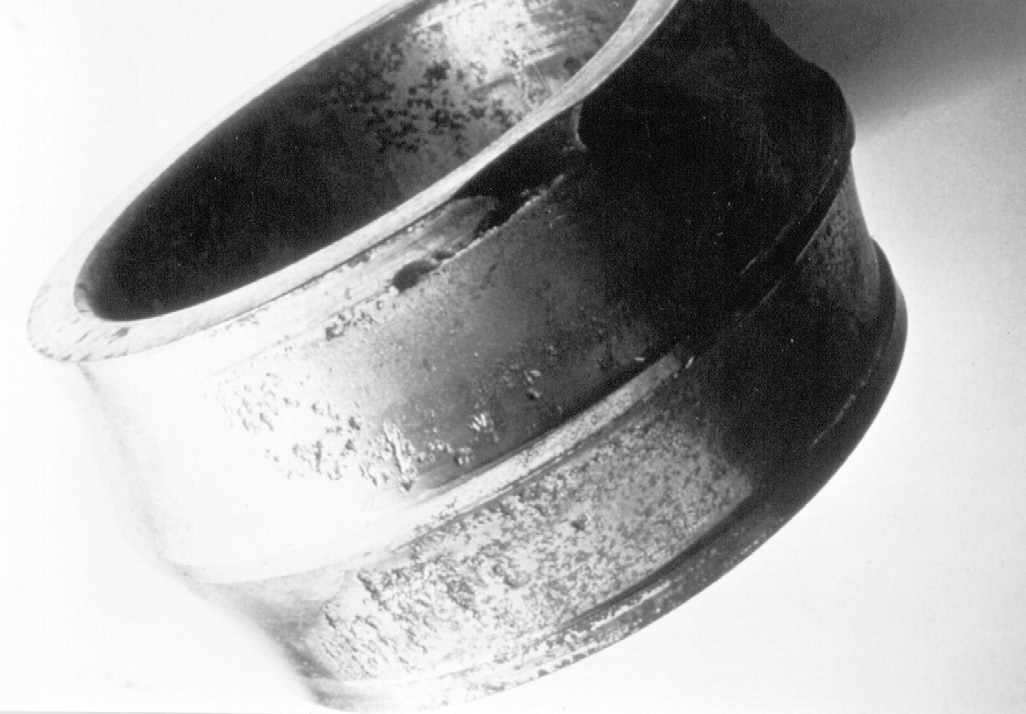
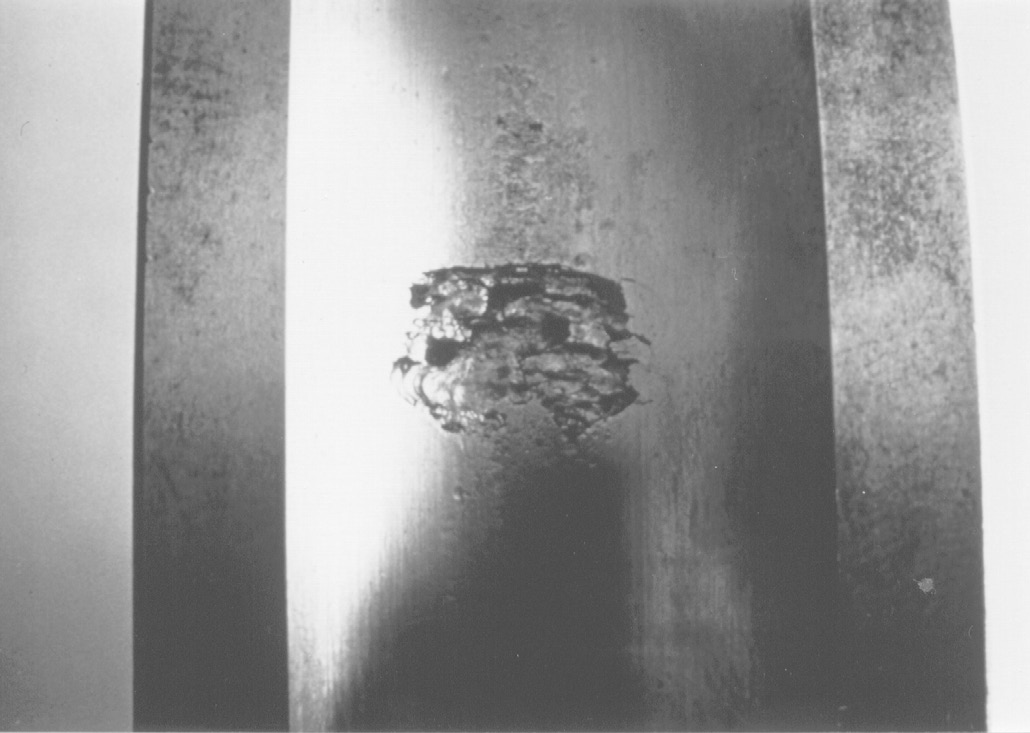
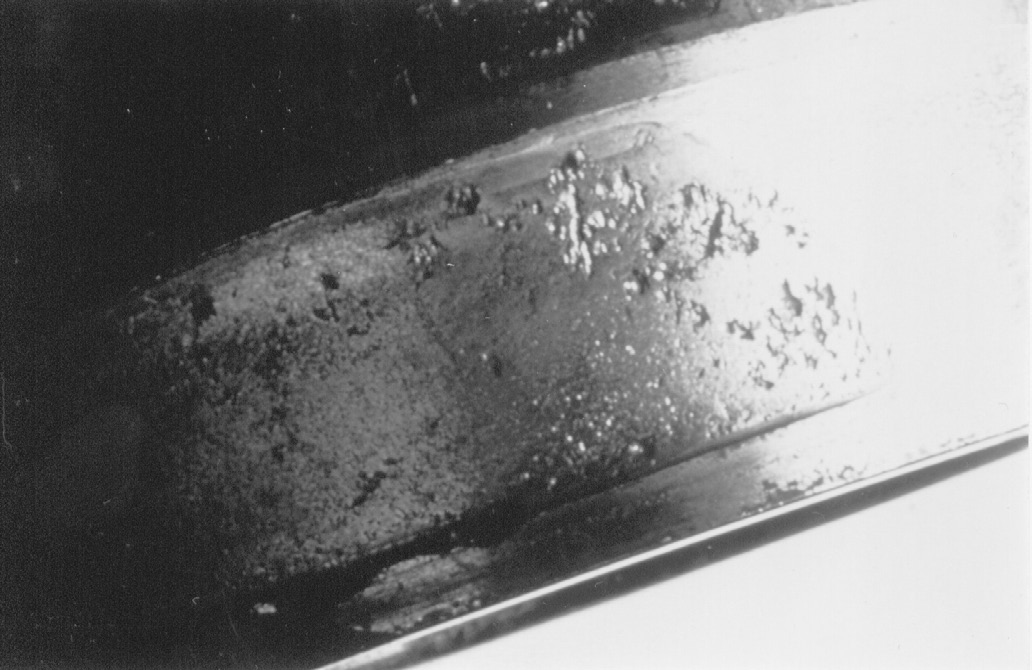
Figure 1. Effect of Sheave
Figure 2. Effect of Sheave
Figure 3. Effect of Shaft Position on Bearing Life
Location on Bearing Life
Diameter on Bearing Life
1400 RPM, 15 HP MOTOR
HEAVY DUTY BALL BEARINGS
17/16" HEAVY DUTY
17/16" HEAVY DUTY
SHEAVE L-10 LIFE SHEAVE L-10 LIFE
POSITION
L-10 LIFE
L-10 = 49,800 HRS.
L-10 = 13,400 HOURS
Bearing Failures and Their Causes
Figure 5. Normal Fatigue Failure
The L-10 life discussed earlier is an estimate of the
fatigue life of a bearing. However, there are many other
factors that determine how long a bearing lasts. Figure
4 shows the results of one study that looked at the
reasons for bearing failure. What is interesting about this
study is that it shows that normal fatigue is not the
normal cause of bearing failure, since only 34% of the
bearings failed this way. Half of the bearing failures were
due to either inadequate lubrication or contamination.
Other sources list fatigue to be the cause of only 10%
of bearing failures.
Figure 4. Bearing Failure Causes
36% - Inadequate Lubrication
34% - Normal Fatigue
14% - Contamination
16% - Other Causes Such as:
Static Vibration
Figure 6. Spall
Electric Currents
Source: Rolling Bearing Digest, 1985
If bearings that are failing can be taken out of service
before they are completely destroyed, they can reveal
information about the cause of failure. Different modes
of failure leave unique evidence in the bearing compo-
nents. The rest of this article shows how the more
common types of fan bearing failures affect bearing
Figure 5 shows an inner race that has had a normal
fatigue failure. The repeated loading and unloading of
the race every time a roller passes eventually causes
microscopic fatigue cracks to form under the surface.
In time, these cracks grow to the point where small
Figure 7. Spalls & Wear Patterns in the Race
portions of the surface flake off. This process is called
"spalling" and the flaws left in the surface are called
With continued operation, the spalls grow until the
bearing becomes noticeably noisy. Figure 6 shows an
inner race that has a severe spall. In addition to being
noisy, it is also likely that this bearing would show high
levels of vibration. The time required for the spalling to
cause catastrophic bearing failure will vary with the load
on the bearing and its speed. Usually the bearing will
run for a while after it becomes noisy, but once noise
is heard, prepare to have the bearing changed before it
fails suddenly.
Inadequate lubrication can lead to spalling as seen in
Figure 7. This bearing also shows signs of excessive
Fan Engineering FE-1300
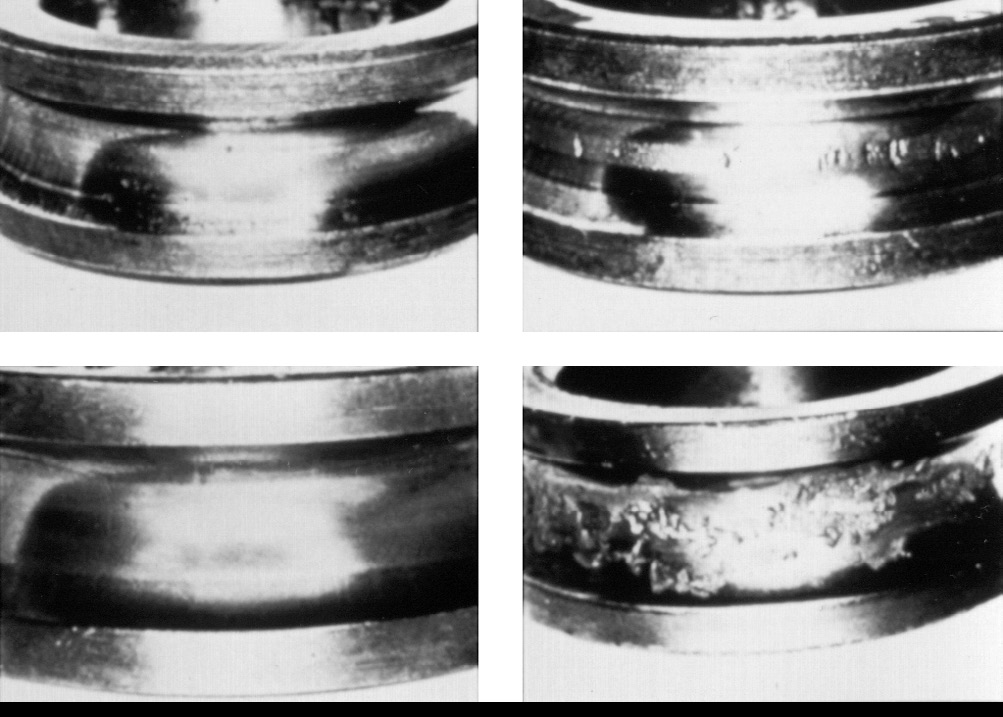
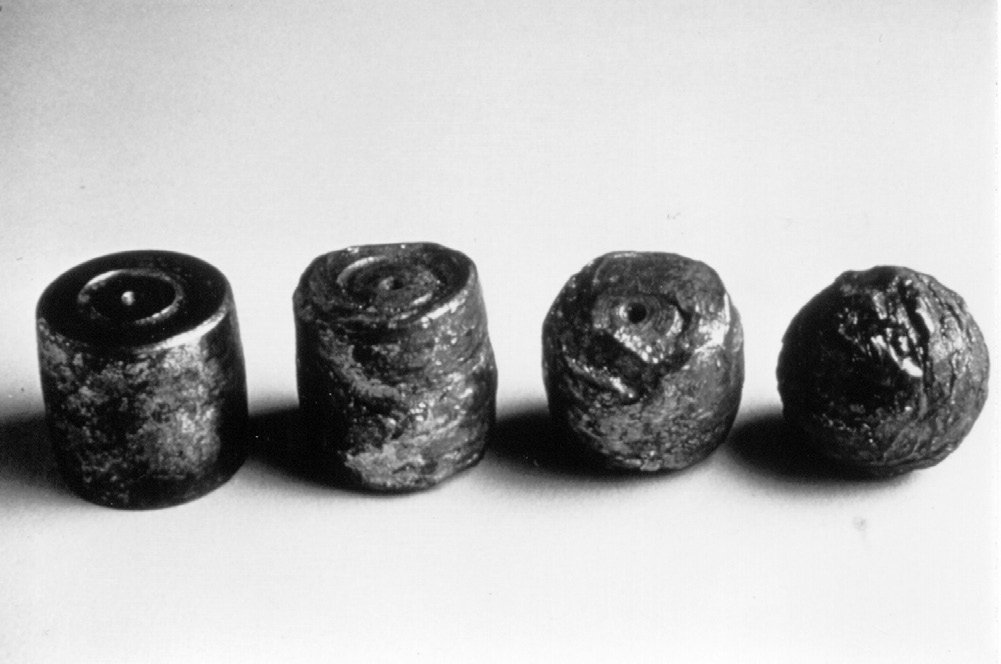
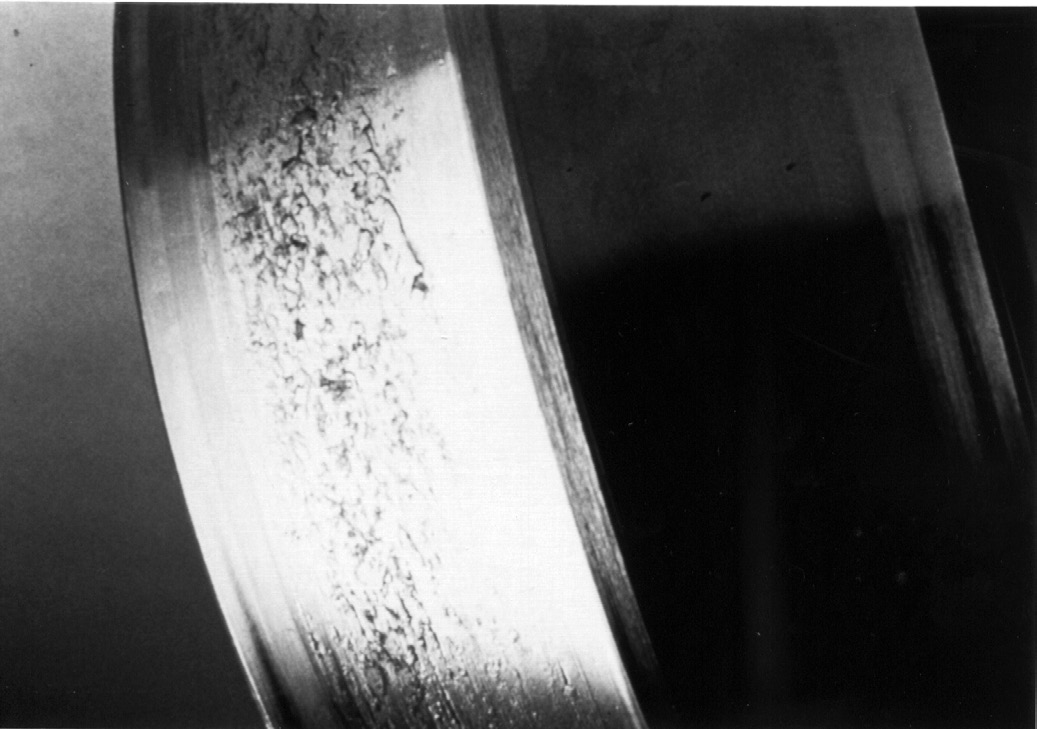
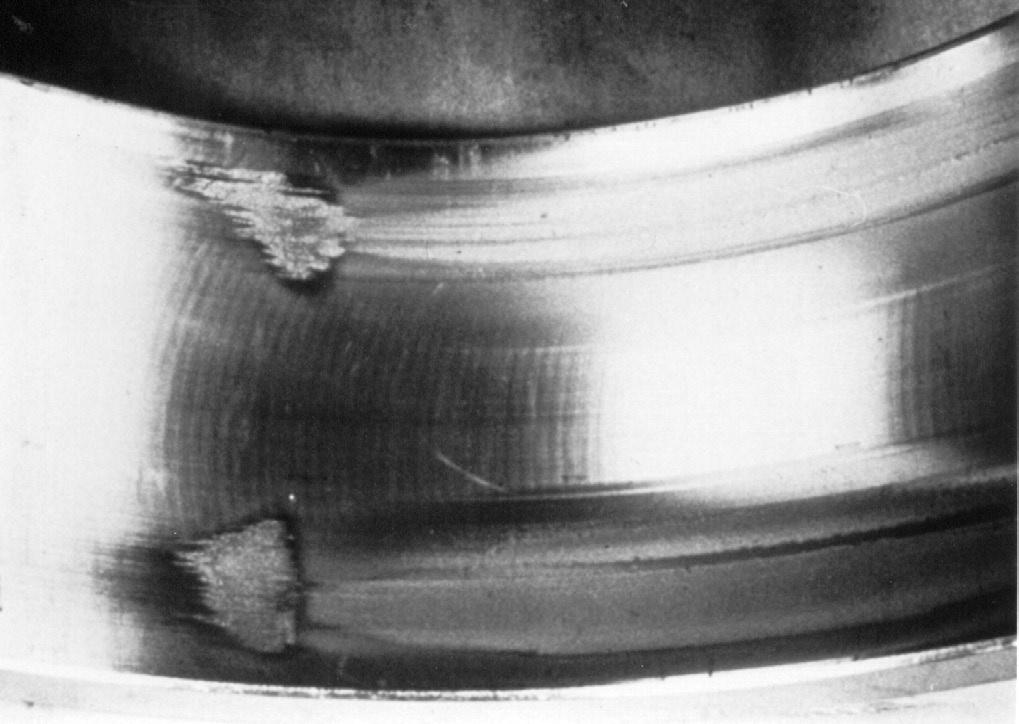
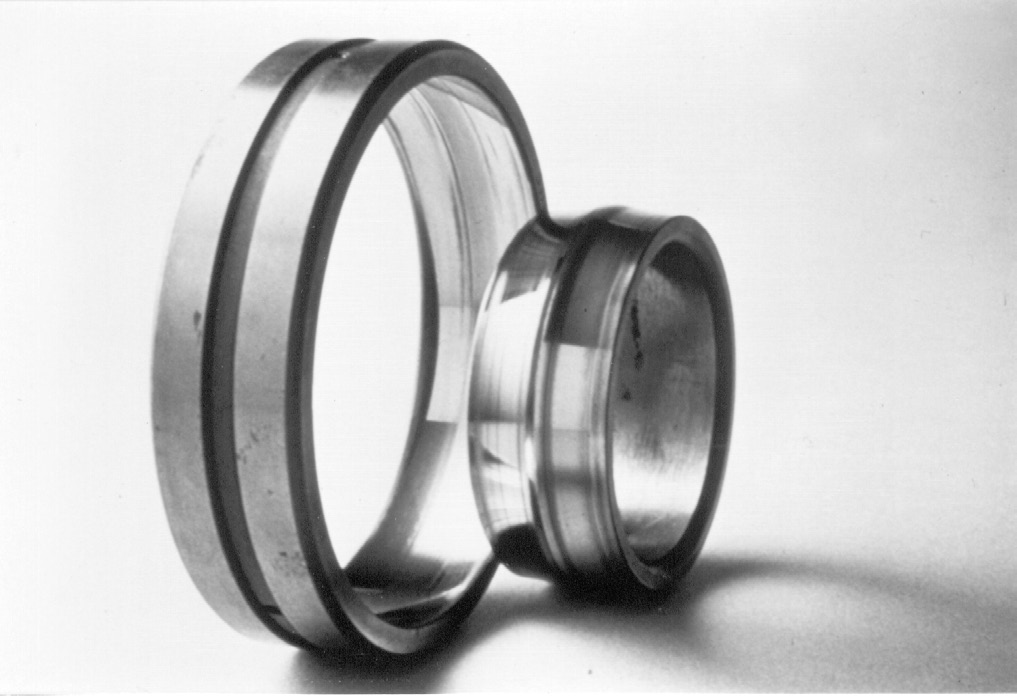
wear due to inadequate lubrication. The rollers have
Figure 10. Smearing
worn a very deep wear pattern in the race.
Inadequate lubrication does not mean that there is no
lubrication, only that the lubricant is not preventing
metal-to-metal contact. This can be due to adding an
insufficient amount of lubricant when relubricating, too
long of a period between relubrications, using dirty lubri-
cant, or using a lubricant that does not have the viscos-
ity needed to maintain an oil film between the parts.
Figure 8 shows the progressive failure of a bearing
due to inadequate lubrication. At first there are traces
of waviness, or a slight roughening of the race. With
time small cracks develop, which lead to a modest
amount of spalls and eventually the severe amount of
spalling shown on the lower right.
Figure 8. Progressive Failure of a Bearing Due to
Inadequate Lubrication
Figure 11. Skid Smearing
Figure 12. Highly Polished Surfaces Due to
If the bearings continue to operate with inadequate
lubrication, the evidence that shows this to be the mode
of failure becomes destroyed. Notice how the spherical
bearing rollers shown in Figure 9 become damaged with
continued operation.
Figure 9. Damaged Spherical Bearing Rollers
If the bearing had been taken out of operation when
the roller was in the condition shown on the left, it would
unloaded to being under load. With the light load it
be possible to determine the cause of failure. By the
takes them some distance to roll properly, and they skid
time the bearing completely failed, it had run so hot that
against the race causing smearing.
the steel softened and the bearing became deformed. At
Inadequate lubrication can sometimes cause the bear-
this point it is impossible to tell what caused the initial
ing surfaces to become highly polished as Figure 12
failure. If you are having unexplained bearing failures, it
shows. Even though the surface looks nice, this is an
is best to take the bearing out of service when you first
indication of trouble. With continued operation the surface
notice noisy, hot, or vibrating operation. The evidence
will change to a frosty appearance and eventually spall.
showing the initial cause of failure is probably still visible,
Material that flakes out of spalls and other contami-
and it will give you an idea as to what action to take
nants from other sources such as dirty grease or worn
to prevent additional failures.
seals dents the races when caught between the rollers
Under the right conditions the heat generated by
and races. Figure 13 shows an inner race with severe
metal-to-metal contact causes the two surfaces to
particle denting. Figure 7 also shows signs of particle
adhere for an instant. Small portions tear out from one
denting. Each dent is a stress concentrator, which
surface and adhere to the other surface. This is "smear-
increases the stress in the area around the dent and
ing" and is shown in Figure 10.
accelerates the fatigue failure process.
"Skid smearing," shown in Figure 11, occurs on
Keeping moisture out of bearings is necessary to
lightly loaded bearings. As the rollers come around and
achieve long life. Figure 14 shows a bearing severely
enter the lower half of the bearing, they go from being
damaged from water corrosion. This much damage was
Fan Engineering FE-1300
Figure 13. Severe Particle Denting
Figure 14. Water Corrosion
probably due to seal failure, possibly in a "wash down"
environment. High moisture applications require the use
of grease that has rust inhibiting properties. Frequent
Figure 15. Bearing Roller with Rusty Ends
relubrication is necessary, to insure that all bearing sur-
Due to Moisture in the Lubricant
faces are coated with a protective layer of grease and
that the rust inhibitors are replenished. Figure 15 shows
a spherical roller bearing roller that has rusty ends from
moisture in the lubricant.
Water from condensation causes corrosion in idle
fans. This is particularly true for fans in high moisture
areas, located outdoors, or improperly stored outdoors.
Figure 16 shows an outer race damaged by puddle cor-
rosion. Moisture or dew condensing in the bearing settles
to the bottom of the race in puddles and causes rusting.
Twin City Fan Companies packs ball and unit roller bear-
ings completely full of grease prior to shipment. Split
pillow block spherical roller bearings are shipped with
Figure 16. Puddle Corrosion
the bearing insert packed full. This minimizes the chanc-
es of having puddle corrosion occur during shipment and
storage. This practice covers all components with grease,
and insures there are no pockets of air where water can
condense. At startup the excess grease purges out of
the bearing, which gets a little messy but is better than
having a damaged bearing.
Figure 17 shows damage to an outer race from a
bearing subjected to vibration while the unit is not rotat-
ing. Notice the even spacing of the marks, which cor-
respond to the roller spacing. You can also see marks
where the rollers came to rest in different locations. This
type of damage, called "false brinnelling," occurs when
Figure 17. False Brinneling
small portions of the race get rubbed away. The remain-
ing area is ideal for starting fatigue, and the abrasive
material rubbed off contaminates the grease which
accelerates bearing wear.
"True brinnelling" occurs when a bearing is subjected
to impact and the rollers dent the races. Figures 18 and
19 show damage caused by improper mounting. Impact
from hammering on the outer race or the bearing hous-
ing causes true brinnelling of the races. If it is necessary
to tap on a bearing to get it into position, tap on the
inner race so that the rolling elements do not carry the
load. Dropping a bearing prior to mounting can also
cause true brinnelling. Like false brinnelling, the marks
are evenly spaced and the damage will eventually
Figure 18. True Brinneling
develop into spalls. Figure 20 shows spalls resulting
from true brinnelling.
Mounting a bearing pillow block on a warped or
crowned surface, or improperly shimming a pillow block
can pinch the outer race. As seen in Figure 21, this
causes two load zones on the outer race 180° apart.
As the rolling elements pass through the pinched
area, the load between them and the races increases.
If the severity of the pinch is high, a drastic reduction
in the life of the bearing will result.
Too much clearance between the bore of a bearing
and the shaft, or too tight of a fit, can lead to bearing
Fan Engineering FE-1300
failures. Figure 22 shows the surface of a bearing bore
Figure 22. Smearing on a Bearing Race
that had too much clearance. The shaft turned in the
bore, smearing the surface.
Insufficient tightening of the setscrews on a set-
screw mounted bearing causes this type of failure. It
can also be caused on a tapered adapter mounted
bearing by not tightening the adapter lock nut enough.
The damage to the surface resulted in a crack.
The bore of the bearing shown in Figure 23 shows
signs of serious fretting corrosion. Microscopic move-
ment be-tween the shaft and the bore causes the rust
colored patches to develop. Small amounts of fretting
are common with setscrew mounted bearings and are
not detrimental to bearing life. Advanced cases, caused
by loose mounting, can lead to cracks.
Tightening the locknut of an adapter mounted bearing
Figure 23. Fretting Corrosion on Bearing Bore
too much can crack the inner race as shown in Figure
24, or the outer race as shown in Figure 25.
This also occurs by exposing the bearing on a high
temperature fan to excessive temperatures. This easily
happens when shutting down high temperature fans
when they are hot, or by exposing them to high tem-
peratures while idle.
Figure 19. True Brinneling
Figure 24. Cracked Inner Race
Figure 20. Spalls Resulting from True Brinneling
Figure 25. Cracked Outer Race
Figure 21. Two Load Zones on the Outer Race
Figure 26. Pits Caused By Electrical Current
Fan Engineering FE-1300
Allowing electrical current to pass through a bearing can cause damage. Figure 26 shows a spherical roller with
pits in its surface caused by electrical current. This type of damage commonly occurs when welding balance weights
on a fan wheel with improper grounding. To avoid having the welding electrical current pass through the bearings,
attach the grounding clamp to the wheel or shaft when adding balance weights.
Summary
There are several different types of rolling element bearings used for fan applications. The best choice is the one
that provides adequate L-10 life with reasonable cost. Proper care during mounting, shipment, storage, and operation
is required in order for the bearings to achieve the theoretical L-10 life they were selected for.
References
Bearing Installation and Maintenance Guide, SKF USA Incorporated, King of Prussia, Pennsylvania, 1992
SKF General Catalog, SKF USA Incorporated, King of Prussia, Pennsylvania, 1991
Bearing Technical Journal, PTC Components Incorporated, Indianapolis, Indiana, 1982
Bearing Failure: Causes and Cures, The Barden Corporation, Danbury, Connecticut, 1992
Dodge Engineering Catalog, Volume 1.1R, Reliance Electric Industrial Company, Greenville, South Carolina, 1993
Sealmaster Bearing Products, Morse Industrial, Emerson Power Transmission Corporation, Ithaca, New York, 1988
Eugene R. Hafner, "Selecting Bearings for Fans and Blowers" Machine Design, April 29, 1990
Photographs in Figures 5 through 26 are courtesy of SKF USA Incorporated
TwIN cITy FAN & blowER www.TcF.com
5959 Trenton lane N minneapolis, mN 55442 Phone: 763-551-7600 Fax: 763-551-7601
Source: http://azen.com.sg/wp-content/uploads/2013/05/fan-bearing-maintenance-troubleshooting-fe-1300.pdf
We've been manufacturing portable data collectors for a long time. When it came time to design a new family of products, Videx engineers started with a blank piece of paper and a list of customer requests. As a • Contact bar code reader result, they gave special attention to three important design elements: • Touch Memory a durable case, a simple-to-use yet long-lasting battery system, and
Selección de lecturas sobre Fisiología del desarrollo Humano Recopilado por: Msc. Leticia Moreno Álvarez Lic. Marlene Escobar Peraza 1. Desarrollo físico. Dr. Gilberto García Batista. 2. Características del desarrollo físico en las diferentes etapas de la vida. Dr. Gilberto García Batista. 3. Procedimientos para la evaluación del desarrollo físico en el escolar












